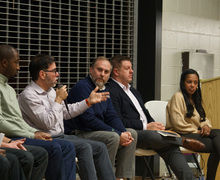There’s beauty in the brains. We need more women in STEM
Sarah Allam | Head Illustrator
For women in STEM, shooting for the moon is just as tough as breaking the glass ceiling.
There have long been wage discrepancies in academia, as seen in Syracuse University’s latest faculty salary report. And, as with most forms of gender discrimination, women of color are more vulnerable to these biases. Speculation surrounding these biases permeated the recent removal of astronaut Jeanette Epps, a Syracuse native, from a NASA space mission set for June. Epps would have been the first black crew member on the International Space Station.
The gender gap in STEM fields is among the most persistent — and consequential — gender divides. While STEM degrees and jobs have grown, the number of women joining and staying in them has not. In 2015, women made up 51 percent of the population but held just 24 percent of STEM positions in the United States, according to the Economics & Statistics Administration. This number has also dropped over time; women held 32 percent of STEM positions in 1990, according to the Pew Research Center.
Combating underrepresentation issues in STEM — including gender stereotypes, a lack of encouragement for women’s interest in STEM and sexual harassment in the workplace — begins with the acknowledgement of the underlying power dynamics and biases that inform the gender gap.
Sharon Alestalo, the program director of the SU WiSE chapter, which supports women student and faculty development in STEM, recognizes this.
“Systemic and personal bias continues to operate in our organizations, communities and nations, inhibiting large portions of our population from realizing their potential,” Alestalo said.
Nurturing women’s interest is integral to equal representation. Yet, recruiting more women to pursue STEM careers only addresses part of the problem, as women are more likely to leave STEM positions than their men counterparts.
“This exodus is frequently referred to as the ‘leaky pipeline’ and holds true from grade school through attainment of a faculty or professional position in STEM,” Alestalo said.
The biases that prevent young women’s pursuit of STEM careers also inform the rampant discrimination they experience once they enter these fields. The #MeToo movement has resulted in heightened awareness of the ubiquity of sexual harassment across industries, including STEM fields.
The challenges women in STEM face require intersectional solutions, as organizations here in Syracuse acknowledge through their work. WiSE sponsors a Women of Color in STEM program, and the upcoming “This Girl Can” program is sponsored by the Onondaga County YWCA.
The work of these organizations, along with the continued dismantlement of gender stereotypes, is critical in closing the STEM gender gap. It will involve creating more opportunities for women — especially women of color — in STEM, along with calling out the inequities that plague virtually every discipline.
Gender underrepresentation in STEM is not just a women’s issue. Having a diverse STEM workforce is vital in the generation of ideas, technologies and economic systems that serve a variety of populations and interests.
When we invest in championing the women of today, we invest in the success of generations of women to follow.
C.C. Hendricks is a doctoral candidate in composition and cultural rhetoric. Her column appears biweekly. She can be reached at crhen100@syr.edu.
Published on February 6, 2018 at 10:40 pm





